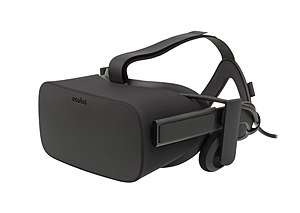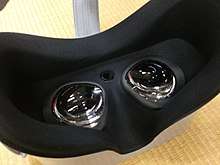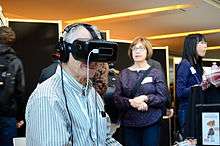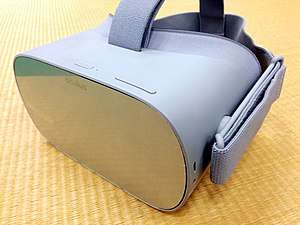Oculus VR
Oculus is a brand of Facebook Technologies, LLC, a subsidiary of Facebook Inc. Founded by Palmer Luckey, Brendan Iribe, Michael Antonov and Nate Mitchell in July 2012 in Irvine, California, now based in Menlo Park. It specializes in virtual reality hardware and software products.
 | |
| Division | |
| Industry | Virtual reality |
| Founded | August 2012 in Irvine, California, U.S. |
| Founders |
|
| Headquarters | , U.S. |
Area served | Worldwide |
Key people |
|
| Products | |
| Brands | Oculus Rift |
| Services | Oculus Store |
| Owner | Facebook Technologies, LLC |
Number of employees | 326 (2020) |
| Parent | Facebook, Inc. |
| Divisions | Oculus Studios |
| Subsidiaries |
|
| Website | oculus |
In April 2012, Luckey announced the Rift, a virtual reality headset designed for video gaming, and launched a Kickstarter campaign in August to make virtual reality headsets available to developers. The campaign proved successful and raised $2.4 million, ten times the original goal of $250,000. Two pre-production models were released to developers; the Oculus VR DK1 (Development Kit 1) and Oculus VR DK2 (Development Kit 2). The consumer product was released on March 28, 2016 with an all-new design incorporating specialized VR displays, positional audio, and infrared tracking system.
In March 2014, Facebook, Inc. acquired Oculus for US$2.3 billion in cash and stock.[1][2][3]
In 2015, Oculus acquired Surreal Vision, a British startup focused on 3D reconstruction and mixed reality, stating that it could be possible for Oculus to develop products with the concept of telepresence.
The company partnered with Samsung to develop the Samsung Gear VR in November 2015 for the Samsung Galaxy smartphones.[4] Zuckerberg would like to have 1 billion virtual reality headsets in consumers' hands.[5]
In June 2019 Oculus announced it sold $5 million worth of content for the Oculus Quest in just 2 weeks.[6]
History

Founding
As a head-mounted display (HMD) designer at the University of Southern California Institute for Creative Technologies, Palmer Luckey earned a reputation for having the largest personal collection of HMDs in the world, and was a longtime moderator in Meant to be Seen (MTBS)'s discussion forums.[7]
Through MTBS's forums,[8] Palmer developed the idea of creating a new head-mounted display that was both more effective than what was currently on the market and was also inexpensive for gamers. To develop the new product, Luckey founded Oculus VR with Scaleform co-founders Brendan Iribe and Michael Antonov,[9] Nate Mitchell and Andrew Scott Reisse.[10]
Coincidentally, John Carmack of id Software had been doing his own research on HMDs and happened upon Palmer's developments as a fellow MTBS member.[11] After sampling an early unit, Carmack favored Luckey's prototype and just before the 2012 Electronic Entertainment Expo (E3), id Software announced that their future updated version of Doom 3, Doom 3 BFG Edition, would be compatible with head-mounted display units.[12]
During the convention, Carmack introduced a duct taped head-mounted display, based on Palmer's Oculus Rift prototype, which ran Carmack's own software. The unit featured a high speed IMU and a 5.6-inch (14 cm) LCD, visible via dual lenses that were positioned over the eyes to provide a 90 degree horizontal and 110 degree vertical stereoscopic 3D perspective.[13][14] Carmack later left id Software as he was hired as Oculus VR's Chief technology officer.[15]
Funding for Oculus Rift and company

Following the demonstration of the Oculus Rift prototype at E3 in June 2012.
On August 1, 2012, the company announced a Kickstarter campaign to further develop the product. Oculus announced that the "dev kit" version of the Oculus Rift would be given as a reward to backers who pledged $300 or more on Kickstarter, with an expected shipping date set of December 2012 (though they did not actually ship until March 2013).[16]
There was also a limited run of 100 unassembled Rift prototype kits for pledges over $275 that would ship a month earlier. Both versions were intended to include Doom 3 BFG Edition, but Rift support in the game was not ready, so to make up for it they included a choice of discount vouchers for either Steam or the Oculus store.[17] Within four hours of the announcement, Oculus secured its intended amount of US$250,000,[18][19] and in less than 36 hours, the campaign had surpassed $1 million in funding,[20] eventually ending with $2,437,429.[21]
On December 12, 2013, Marc Andreessen joined the company's board when his firm, Andreessen Horowitz, led the $75 million Series B venture funding.[22] In total, Oculus VR has raised $91 million with $2.4 million raised via crowdfunding.[17]
Facebook acquisition and chief scientist designation
Although Oculus had only released a development prototype of its headset, on March 25, 2014, Mark Zuckerberg announced that Facebook, Inc. would be acquiring Oculus for US$ 2 billion, pending regulatory approval. The deal includes $400 million in cash and 23.1 million common shares of Facebook, valued at $1.6 billion, as well as additional $300 million assuming Facebook reaches certain milestones.[1][2][3] This move was ridiculed by some backers who felt the acquisition was counter to the independent ideology of crowdfunding.[23]
Many Kickstarter backers and game industry figures, such as Minecraft developer Markus Persson, criticized the sale of Oculus to Facebook.[24][25] On March 28, 2014, it was announced that Michael Abrash had joined the company as Chief Scientist.[26]
As of January 2015, the Oculus headquarters has been moved from Irvine, California to Menlo Park, where Facebook's Headquarters is also located. Oculus has stated that this move is for their employees to be closer to Silicon Valley.[27]
Partnership with Samsung
In 2014, Samsung partnered with Oculus to develop the Gear VR, after the success of the then-in-development Rift.[28]
During the course of 2014-15, two Innovator Editions (in-development versions of the Gear VR mainly sold to developers for sole research and understanding) were developed, manufactured, and sold.[29] The device that the Innovator Editions used was the Note 4.[30]
On November 20, 2015, the consumer edition of the Gear VR was released to the public, and sold out during the first shipments. The device supported the Samsung Galaxy Note 5, Samsung Galaxy S6, Samsung Galaxy S6 Edge, Samsung Galaxy S6 Edge+, and later, the Samsung Galaxy S7, and Samsung Galaxy S7 Edge.[31]
Further expansion
In May 2015, Oculus acquired British company Surreal Vision, a company based on 3D scene-mapping reconstruction and augmented reality. News reported that Oculus and Surreal Vision could create "mixed reality" technology in Oculus' products, similar to the upcoming HMD, Microsoft HoloLens.[32] They reported that Oculus, with Surreal's help, will make telepresence possible.[33]
On December 28, 2016 media reported that Facebook, the parent company of Oculus, has acquired the Danish startup The Eye Tribe for an undisclosed amount. The company delivers eye tracking technology used to improve virtual reality user experience and has developed foveated rendering, a technology that only renders at the highest resolution where the user is looking. A lower resolution is used further away from the center of the visual field, reducing computation time.[34]
In September 2018, Oculus became a division of a new structural entity within Facebook known as Facebook Technologies, LLC.[35] Facebook announced in August 2018 they had entered negotiations to lease the entire Burlingame Point campus in Burlingame, California, then under construction.[36] The lease was executed in late 2018, and the site, owned by Kylli, a subsidiary of Genzon Investment Group, is expected to be complete by 2020.[37] Oculus is expected to move to Burlingame Point when development is complete.[38]
On August 13, 2019, Nate Mitchell, Oculus co-founder and VP of product announced his departure from the company.[39]
On November 13, 2019, John Carmack wrote in a Facebook post that he would step down as CTO of Oculus to focus on developing artificial general intelligence. He stated he would remain involved with the company as a "Consulting CTO."[40]
ZeniMax v. Oculus
Following Facebook's acquisition of Oculus VR, ZeniMax Media, the parent company of id Software and John Carmack's previous employer, sought legal action against Oculus, accusing the company of theft of intellectual property relating to the Oculus Rift due to Carmack's transition from id Software to Oculus. The case, ZeniMax v. Oculus, was heard in a jury trial in the United States District Court for the Northern District of Texas, and their verdict was reached in February 2017, finding that Carmack had taken code from ZeniMax and used it in developing the Oculus Rift's software, violating his non-disclosure agreement with ZeniMax, and Oculus' use of the code was considered copyright infringement. ZeniMax was awarded $500 million in the verdict, and both ZeniMax and Oculus are seeking further court actions.[41][42]
Products
Oculus's current product line consists of three models; the Oculus Rift S headset for PCs, as well as Oculus Go and Oculus Quest—standalone headsets which contain integrated mobile computing hardware and do not require a PC to operate. In 2018, Facebook CEO Mark Zuckerberg stated that the original Oculus Rift "CV1", Go, and Quest were the company's first generation of products, and expected new iterations of the three to be developed for a second generation of the company's technology.[43] Oculus began to phase out the original Oculus Rift "CV1" in 2019, in favor of the Oculus Rift S.[44]
Oculus Rift

The Oculus Rift CV1, also known as simply the Oculus Rift, was the first consumer model of the Oculus Rift headset. It was released on March 28, 2016 in 20 countries, at a starting price of US$599.[45] The 6,955 backers who received the Development Kit 1 prototype via the original Oculus Rift Kickstarter campaign were eligible to receive the CV1 model for free.[46] On December 6, 2016, Oculus released motion controller accessories for the headset known as Oculus Touch.[47]
Oculus Go

On October 11, 2017, Oculus unveiled the Oculus Go, a mobile VR headset manufactured by Xiaomi (the device was released in the Chinese market as the Xiaomi Mi VR). Unlike the Oculus Rift, the Go is a standalone headset which is not dependent on a PC for operation. Unlike VR systems such as Cardboard, Daydream, and the Oculus co-developed Samsung Gear VR (where VR software is run on a smartphone inserted into a physical enclosure, and its screen is viewed through lenses), it contains its own dedicated display and mobile computing hardware. The headset includes a 5.5-inch 1440p fast-switching LCD display, integrated speakers with spatial audio and a headphone jack for external audio, a Qualcomm Snapdragon 821 system-on-chip, and 32 or 64 GB of internal storage. It runs an Android-based operating system with access to VR software via the Oculus Home user experience and app store, including games and multimedia apps. The Go includes a handheld controller reminiscent of one designed for the Gear VR, which uses relative motion tracking. The Oculus Go does not use positional tracking.[48][49][50]
While official sales numbers have not been released, according to IDC the Oculus Go and Xiaomi Mi VR had sold nearly a quarter million units combined during the third quarter 2018,[51] and in January 2019 market analysis firm SuperData estimated that over a million Oculus Go units had been sold since the device's launch.[52] In his keynote at 2018's Oculus Connect developer conference, John Carmack revealed that the Go's retention rate was as high as the Rift's, something that nobody at the company had predicted.[53] Carmack also noted that the Go had done especially well in Japan despite lacking internationalization support and the company not specifically catering to the Japanese market.[54]
Oculus Go was declared end-of-life in June 2020, with software submissions to end in December 2020, and firmware support ending in 2022.[55]
Oculus Quest

On September 26, 2018, Facebook unveiled Oculus Quest. It was originally unveiled as a higher-end counterpart to the Oculus Go, and part of a goal to reach one billion VR users. Similarly to Oculus Go, it uses embedded mobile hardware, including a Snapdragon 835 system-on-chip, and 64 or 128 GB of internal storage. The Quest uses OLED displays with a resolution of 1600x1440 per-eye and running at 72 Hz. It supports Oculus Touch controllers via an "inside-out" motion tracking system known as "Oculus Insight", which consists of a series of cameras embedded in the headset. The controllers were redesigned to properly function with Insight.[56]
It supports games and applications downloaded via Oculus Store, with ported launch titles such as Beat Saber and Robo Recall. It also supports cross-platform multiplayer and cross-buys between PC and Quest.[57][58] Facebook stated that they would impose stricter content and quality standards for software distributed for Quest than its other platforms, including requiring developers to undergo a pre-screening of their concepts to demonstrate "quality and probable market success".[59]
In November 2019, Facebook released a beta for a new feature known as Oculus Link, which allows the Quest to be attached to a PC over USB 3.0 for use with Oculus Rift-compatible software.[60] In May 2020, Facebook added additional support for the use of USB 2.0 cables, such as the charging cable supplied with the headset. Support for controller-free hand tracking was also launched that month.[61][62]
Oculus Rift S
On March 20, 2019 at the Game Developers Conference, Facebook announced the Oculus Rift S, a successor to the original Oculus Rift headset.[63] It was co-developed with and manufactured by Lenovo, and launched at a price of US$399. The Rift S contains hardware features from the Oculus Go and Oculus Quest, including Oculus Insight, integrated speakers, and a new "halo" strap. The Rift S uses the same 1440p fast-switching LCD display and lenses as the Oculus Go (a higher resolution in comparison to the original model, but lower in comparison to Oculus Quest), running at 80 Hz, and is backwards compatible with all existing Oculus Rift games and software. Unlike the original Oculus Rift, it does not have hardware control for inter-pupillary distance.[57][58]
Oculus Studios
Oculus Studios is a division of Oculus that focuses on funding, publishing and giving technical advice to third party studios to create games and experiences for Oculus Rift. Facebook pledged to invest more than $500 million USD in Oculus Studios for games.[64][65][66] By 2020, Facebook purchased Beat Games[67] and Sanzaru Games[68] studios and integrated them with Oculus Studios. Ready at Dawn, a game studio composed by former members of Naughty Dog and Blizzard Entertainment, developers of the acclaimed Lone Echo, was acquired by Oculus in June 2020, though will continue to operate as its own subsidiary studios for Oculus.[69]
Oculus Story Studio
Oculus Story Studio was an original animated virtual-reality film studio that was founded in 2014.[70] The studio was started by Oculus to pioneer animated virtual reality filmmaking and educate, inspire, and foster community for filmmakers interested in VR.[71]
The studio was led by Creative Director Saschka Unseld, a six-year veteran of Pixar.
Oculus Story Studio was first launched publicly at the 2015 Sundance Film Festival,[72] where they launched three VR films - Dear Angelica, Henry, and Lost - before being closed in May 2017.[73]
References
- "Facebook to Acquire Oculus". Facebook Newsroom. Facebook. March 25, 2014. Retrieved March 26, 2014.
- Plunkett, Luke (March 25, 2014). "Facebook Buys Oculus Rift For $2 Billion". Kotaku.com. Retrieved March 25, 2014.
- Welch, Chris (March 25, 2014). "Facebook buying Oculus VR for $2 billion". The Verge. Retrieved February 2, 2017.
- "IFA 2014: Samsung Galaxy Note 4, Note Edge, Gear VR and Gear S hands-on". GSMArena.com. Retrieved November 24, 2015.
- Facebook Faces Crossroads in Virtual Reality. Tumult at the top of Oculus puts Facebook in a VR bind., Motley Fool, By Travis Hoium, Nov 25, 2018 at 11:38AM
- "Oculus sold $5 million worth of Quest content in first 2 weeks on sale". TechCrunch. Retrieved 2019-06-11.
- "Oculus VR: the $2bn virtual reality company that is revolutionising gaming". telegraph.co.uk. Retrieved May 9, 2017.
- "Oculus "Rift" : An open-source HMD for Kickstarter". Mtbs3d.com. Retrieved 2013-09-09.
- Hollister, Sean. "Under new management, Oculus intends to commercialize the virtual reality headset". theverge.com. Retrieved August 16, 2012.
- "Santa Ana police chase: Pedestrian identified". Archived from the original on March 27, 2014. Retrieved March 26, 2014.
- Neil Schneider. "The #1 Stereoscopic 3D Gaming (VR Gaming, 3D Gaming) and VR Resource - Meant to be Seen - John Carmack Talks VR at QuakeCon 2012". mtbs3d.com. Retrieved February 2, 2017.
- "Carmack Makes Virtual Reality Actually Cool".
- "John Carmack and the Virtual Reality Dream". Eurogamer. June 7, 2012. Retrieved August 1, 2012.
- Rosenberg, Adam (June 14, 2012). "Hands-On With Oculus Rift, John Carmack's Virtual Reality Goggles". G4TV. Retrieved February 2, 2017.
- Gilbert, Ben. "Oculus Rift hires Doom co-creator John Carmack as Chief Technology Officer". engadget.com. Retrieved August 7, 2013.
- "Update on Developer Kit Technology, Shipping Details". Oculus VR. 2012-11-28. Retrieved 2014-03-20.
- "Oculus Rift: Step Into the Game". Retrieved August 1, 2012.
- "Oculus Rift virtual reality headset gets Kickstarter cash". BBC. August 1, 2012. Retrieved February 2, 2017.
- Matulef, Jeffrey (August 1, 2012). "John Carmack's snazzy VR headset takes to Kickstarter with the Oculus Rift". Eurogamer. Retrieved February 2, 2017.
- "Watch the QuakeCon VR Keynote Tonight Live at 7PM EST. Oculus Rift Kickstarter Passes $1 Million Under 36 Hours « Road to Virtual RealityRoad to Virtual Reality". Roadtovr.com. August 6, 2012. Archived from the original on November 10, 2016. Retrieved February 2, 2017.
- "Oculus Rift Virtual Reality Headset Developer Kits Now Available To Pre-Order". Geeky Gadgets. September 27, 2012. Retrieved February 2, 2017.
- Takahashi, Dean. "Oculus VR raises $75M round led by web browser inventor Marc Andreessen's VC firm to launch virtual-reality goggles". venturebeat.com. Retrieved December 12, 2013.
- Gleasure, R., & Feller, J. (2016). A Rift in the Ground: Theorizing the Evolution of Anchor Values in Crowdfunding Communities through the Oculus Rift Case Study. Journal of the Association for Information Systems, 17(10), 708-36.
- Victor Luckerson (2014-03-26). "When Crowdfunding Goes Corporate: Kickstarter Backers Vent Over Facebook's Oculus Buy". Time. Retrieved 2014-03-26.
- Philippa Warr (2014-03-26). "Minecraft for Oculus Rift axed, Facebook too 'creepy'". Wired. Retrieved 2017-02-01.
- "Introducing Michael Abrash, Oculus Chief Scientist". Retrieved March 28, 2014.
- Leung, Lily. "Oculus moves out: Irvine VR goggles maker moves HQ to Menlo Park, closer to parent Facebook". Retrieved March 16, 2016.
- "IFA 2014: Samsung Galaxy Note 4, Note Edge, Gear VR and Gear S hands-on". GSMArena.com. Retrieved March 16, 2016.
- "Introducing the Samsung Gear VR Innovator Edition". oculus.com. Retrieved March 16, 2016.
- "Introducing the Samsung Gear VR Innovator Edition". oculus.com. Retrieved May 21, 2018.
- "Samsung Gear VR now available for pre-orders at $99". oculus.com. Retrieved March 16, 2016.
- Gaudiosi, John (June 1, 2015). "What the Surreal Vision acquisition means for Oculus". Fortune. Retrieved March 16, 2016.
- Etherington, Darrell (May 26, 2015). "Oculus Acquires Surreal Vision To Bring The Real World to VR". TechCrunch. Retrieved March 16, 2016.
- Constine, Josh (2016-12-28). "Oculus acquires eye-tracking startup The Eye Tribe". 2016-12-29. Retrieved February 2, 2017.
- "Oculus Is Now A Division Of Facebook Technologies". UploadVR. November 16, 2018.
- Aydin, Rebecca (August 16, 2018). "Ever-expanding Facebook plans Burlingame lease". San Francisco Chronicle. Retrieved 30 July 2019.
- Brown, Lisa (January 16, 2019). "Facebook Inks Mega-Lease at Burlingame Point". GlobeSt. Retrieved 30 July 2019.
- "Cushman & Wakefield Arranges $515 Million Financing for New Bay Area Office Campus" (Press release). Cushman & Wakefield San Francisco. April 23, 2019. Retrieved 30 July 2019.
- Rubin, Peter (2019-08-13). "Nate Mitchell Exits Facebook, Taking Oculus Era With Him". Wired. ISSN 1059-1028. Retrieved 2019-08-13.
- Damiani, Jesse. "John Carmack Stepping Down To Focus on Artificial General Intelligence, Remains "Consulting CTO" At Oculus". Forbes. Retrieved 2019-11-18.
- Larson, Selena (February 1, 2017). "Facebook loses $500 million Oculus lawsuit". CNN. Retrieved February 2, 2017.
- Wawro, Alex (June 21, 2017). "After winning $500M in lawsuit against Oculus, ZeniMax pushes for more". Gamasutra. Retrieved June 22, 2017.
- "Facebook CEO Mark Zuckerberg: 'Oculus Quest Completes Company's First-Gen Lineup'". RoadtoVR.com. 2018-10-15. Retrieved 2018-10-18.
- "Oculus "phasing out" Rift, launching $399 Rift S this spring". GamesIndustry.biz. Retrieved 2019-11-27.
- Day, Matt. "CES 2016: Rewind from Day 2 of the Consumer Electronics Show". Seattle Times. Retrieved January 7, 2016.
- Stark, Chelsea. "Oculus will reward its original Kickstarter backers with the new Rift". Mashable. Retrieved January 7, 2016.
- "You can now pre-order Oculus Touch controllers for $199". Engadget. Retrieved March 10, 2017.
- Robertson, Adi (2017-10-11). "Oculus announces new $199 self-contained VR headset called Oculus Go, shipping in 2018". The Verge. Retrieved 2019-11-27.
- Robertson, Adi (May 1, 2018). "The Oculus Go improves mobile VR, but there's still a long way to go". The Verge. Retrieved 2018-09-06.
- Machkovech, Sam (2018-05-01). "Oculus Go review: The wireless-VR future begins today for only $199". Ars Technica. Retrieved 2019-11-27.
- "VR Headset Market Rebounds as Standalone Products Gain Traction While AR Headset Market Also Saw Positive Movement, According to IDC". IDC.com. International Data Corporation. Retrieved 20 May 2019.
- Fogel, Stefanie (January 24, 2019). "Oculus Expected to Sell 1.3 Million Quest Units in 2019, SuperData Believes". Variety. Variety Media, LLC. Retrieved 1 June 2019.
- Carmack, John (September 27, 2018). "Oculus Connect 5 | Keynote Day 02". YouTube. Oculus VR, LLC. 3 minutes 46 seconds. Retrieved 20 May 2019.
Now, I was probably the most optimistic inside Oculus about how well Go would do, but it turned out that it exceeded even my expectations. A remarkable point is, Go is retaining as well as Rift. And that's pretty shocking. Nobody predicted that.
- Carmack, John (September 27, 2018). "Oculus Connect 5 | Keynote Day 02". YouTube. Oculus VR, LLC. 6 minutes 23 seconds. Retrieved 20 May 2019.
The one shock was how well we've done in Japan. … we are not catering to the Japanese market. We don't have great internationalisation for Japanese and different areas, but something about Go has really struck a nerve in the Japanese market consciousness.
- Robertson, Adi (2020-06-23). "Oculus discontinues its low-end Go headset to focus on Oculus Quest". The Verge. Retrieved 2020-07-15.
- Robertson, Adi (2019-04-30). "Oculus Quest review: a great vision with a frustrating compromise". The Verge. Retrieved 2019-11-27.
- "Who needs the Rift S when the Oculus Quest can do everything?". Engadget. Retrieved 2019-11-27.
- Statt, Nick (2019-03-20). "Oculus unveils the Rift S, a higher-resolution VR headset with built-in tracking". The Verge. Retrieved 2019-03-20.
- Robertson, Adi (2019-02-28). "Oculus won't approve Quest games unless it thinks people will buy them". The Verge. Retrieved 2019-11-27.
- Marshall, Cass (2019-11-18). "Your Quest can now play Oculus Rift games, with the right cable and gaming PC". Polygon. Retrieved 2019-11-27.
- Lang, Ben (2020-05-14). "Oculus Quest Can Now Tether to PC with Its Included USB 2.0 Cable". Road to VR. Retrieved 2020-06-23.
- Robertson, Adi (2020-05-18). "Oculus Quest games are getting controller-free hand tracking this month". The Verge. Retrieved 2020-07-16.
- Statt, Nick (2019-03-20). "Oculus unveils the Rift S, a higher-resolution VR headset with built-in tracking". The Verge. Retrieved 2019-11-27.
- Oculus Rift Experiences, accessed 01/22/2019
- Oculus Go Experiences, accessed 01/22/2019
- , Oculus Gear VR Experiences, accessed 01/22/2019
- Facebook buys VR studio behind Beat Saber , accessed 21/06/2020
- Facebook acquires the VR game studio behind one of the Rift’s best titles, accessed 21/06/2020
- Gach, Ethan (June 22, 2020). "Facebook Buys Creators Of The Order: 1886". Kotaku. Retrieved June 22, 2020.
- Zeitchik, Steven (26 January 2015). "Sundance 2015: Virtual-reality company Oculus to launch film label". LA Times. Retrieved 14 November 2016.
- Constine, Josh (26 January 2015). "Oculus' Pixar Exec-Led Story Studio Will Release VR Cinema Examples". TechCrunch. Retrieved 14 November 2016.
- Sundance 2015: Virtual-reality company Oculus to launch film label, Los Angeles Times, By Steven Zeitchik, Jan. 26, 2015
- "Oculus Announces Closure Of Oculus Story Studio". Game Informer. Retrieved 2018-04-11.
External links
| Wikimedia Commons has media related to Oculus VR. |
- Official website

- Official Oculus developer forum
- "Tuscany Demo" using AstoundSound on TrueAudio on YouTube — special version of Oculus VR's "Tuscany Demo" showcasing GenAudio's AstoundSound with calculations shunted to AMD TrueAudio.